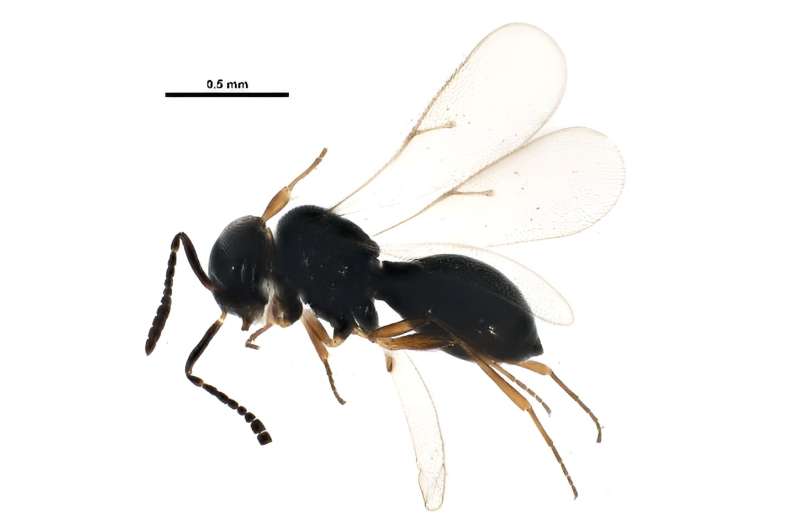
An article published in the journal Insects determines with precision the dispersal range of a type of wasp that neutralizes the brown stink bug, Euschistus heros, a major soybean pest in Brazil and one that is highly resistant to chemical insecticides. The solution discussed by the authors is Telenomus podisi, a parasitoid microwasp first described by American entomologist William Harris Ashmead in 1893.
Parasitoids are small insects whose immature stages develop either within or attached to the outside of other insects. They eventually kill the hosts on which they feed, whereas parasites typically feed on hosts without killing them.
The findings of the study, which was conducted by scientists at São Paulo State University (UNESP) in Brazil and Oklahoma State University (OSU) in the United States, serve as a basis for improving the release of the egg parasitoid to assure biological control of E. heros, which also attacks cotton and sunflower plantations, as well as pasture.
Females of T. podisi locate eggs of E. heros in plants and lay their own eggs there, interrupting the stink bug’s development at an early stage.
“The pest’s eggs become dark in color and give rise to new wasps instead of bugs. These wasps go on to parasitize more eggs of the stink bug,” said Regiane Cristina de Oliveira, last author of the article and a professor in the Department of Crop Protection at the School of Agricultural Sciences (FCA-UNESP) in Botucatu (São Paulo state). Several studies have been conducted there to advise producers on the optimal way to use the biological control system by finding out how many wasps to release and estimate the right distance between release points, among other aspects.
The authors verified in field conditions that the parasitoid’s dispersal capacity, influenced by the soybean crop’s growth stage, varied between 31 m and 39 m, and that at most about 60% of the stink bug’s eggs were parasitized. Based on these results, they recommend that T. podisi release points should be no more than 30 m apart in order to assure sufficient control of stink bugs.
E. heros damages soybean seeds and pods and can cause yield losses of up to 30%. It lodges in the crop in the fall and stays there until summer, all the time accumulating lipids and not feeding but remaining quiescent (in a physiological state involving low metabolic activity).
Because its efficacy depends on the ability to find hosts, knowledge of its dispersal capacity enables growers to adjust logistics and release. “This optimizes management of the bugs via biological control programs implemented in large areas of monoculture,” said Oliveira, who has a first degree in agronomy from the Federal University of Espírito Santo (UFES), a master’s in agricultural entomology from UNESP, and a Ph.D. in entomology from the University of São Paulo’s Luiz de Queiroz College of Agriculture (ESALQ-USP). She pursued postdoctoral studies at Mississippi State University (MSU) in the United States.
The other co-authors of the article are William Wyatt Hoback and Rafael Hayashida of OSU’s Department of Entomology and Plant Pathology; and Gabryele Ramos, Daniel Mariano Santos and Daniel de Lima Alvarez of FCA-UNESP.
More information:
William Wyatt Hoback et al, Optimizing the Release Pattern of Telenomus podisi for Effective Biological Control of Euschistus heros in Soybean, Insects (2024). DOI: 10.3390/insects15030192
Citation:
Research optimizes biological control of pest that severely damages soybean crops (2024, June 3)
retrieved 3 June 2024
from https://phys.org/news/2024-06-optimizes-biological-pest-severely-soybean.html
This document is subject to copyright. Apart from any fair dealing for the purpose of private study or research, no
part may be reproduced without the written permission. The content is provided for information purposes only.


